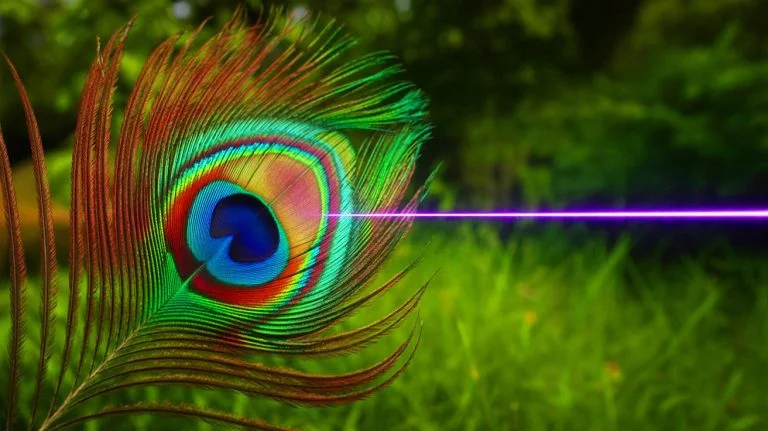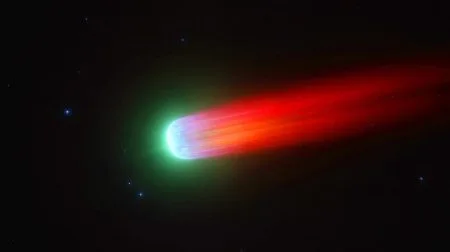| IN A NUTSHELL |
|
In a groundbreaking study, scientists have discovered that peacocks’ tail feathers are capable of emitting laser light, a phenomenon never before observed in the animal kingdom. Researchers from Florida Polytechnic University and Youngstown State University found that the colorful tail feathers of the Indian Peafowl contain unique nanostructures capable of amplifying light into laser beams. This discovery opens up new possibilities for understanding natural optical technologies, potentially leading to innovations in biomaterials and medicine.
First Example of Biolaser Cavity
The study presents the first known example of a biolaser cavity within the animal kingdom. By examining the tail feathers of the Indian Peafowl, researchers identified that these feathers could emit narrow beams of laser light when energized with an external light source. The process involved dyeing the feathers and subsequently exposing them to high-intensity light, resulting in yellow-green laser emissions.
This finding is significant because it demonstrates that biological structures can generate coherent light, similar to artificial lasers. The dyed peacock feathers emitted distinct frequencies of laser light, particularly from the eyespots, which are the colorful regions on the feathers. The study highlights the potential of these biological systems to inspire new technological advancements in optical science.
Highly Conserved Laser Wavelengths
During the research, scientists observed a highly conserved set of laser wavelengths across different feather samples. This consistency was achieved by repeatedly wetting the eyespots with a dye solution and allowing them to dry, followed by exposure to light. The process revealed that the greatest laser intensity was emitted from the green color regions of the feathers.
The repeated staining cycles were crucial in achieving the desired laser emission, and the researchers noted that the visible reflection bands outside the gain region of the dye also emitted laser light in certain areas. This discovery emphasizes the complexity and precision of natural nanostructures in facilitating light amplification.
Precise Microstructures Responsible for the Lasing
The study did not pinpoint the exact microstructures responsible for the lasing effect, though it ruled out the possibility of keratin-coated melatonin rods being the source. The researchers speculated that protein granules or similar small structures within the feathers might function as a laser cavity. This hypothesis suggests that the intricate biological architecture of peacock feathers could support the generation of coherent light.
To conduct their experiments, the research team meticulously prepared the feathers by cutting away excess lengths of barbs and mounting them on absorptive substrates. They then infused the feathers with common dyes and exposed them to light pulses, measuring the resulting emissions. Despite not identifying the precise microstructures, the study provides valuable insights into the potential mechanisms behind biological laser emission.
Implications for Biomaterials and Medicine
The implications of this study extend beyond the realm of biological optics. Experts suggest that the ability to identify laser light in biomaterials could lead to advancements in medicine and technology. For instance, the unique optical properties of biological structures could help identify arrays of regular microstructures, such as viruses with distinct geometric shapes, potentially aiding in medical diagnostics.
The study, published in the journal Scientific Reports, underscores the potential for natural biological systems to inspire technological innovations. By understanding how these complex structures function as natural lasers, scientists could develop new applications in fields ranging from biomaterials to photonics.
This groundbreaking discovery raises intriguing questions about the future of biomimetic technologies. How might these natural laser systems inspire new innovations in science and medicine?
Did you like it? 4.4/5 (25)








Are they serious? Peacocks shooting lasers sounds like something out of a sci-fi movie! 😂
Incredible discovery! Does this mean we could harness this for medical tech? 🤔
How did they even find out about this? Seems pretty random to check peacock feathers for lasers.
This is a joke, right? Next thing you’ll tell me is that pigeons can teleport. 😅
Thank you for sharing this fascinating article! Nature never ceases to amaze. 🌿
Could this research be applied to other birds with colorful feathers?
Seems like a huge leap from peacock feathers to medical advancements. How realistic is this?
Great, now peacocks are armed with lasers… what’s next? 🤣🦚
Did they mention if this could be harmful to the peacocks in any way?
I’m skeptical. Has there been any peer review on this research?
Wow, I never thought peacocks could be involved in technological innovations. Mind-blowing!
This could open up so many possibilities in photonics and biomaterials!
Peacocks with laser tails? Sounds like superhero material to me. 🦚🔫
Is this phenomenon visible to the naked eye, or do we need special equipment to see it?
Incredible research! How long did this study take to complete?
Lasers from peacock feathers? Mother Nature sure has her secrets! 🌍✨
Can they use this discovery to advance solar energy technologies?
Why did they use dye on the feathers? Does it affect the natural colors?
Looks like we have a real-life “Laser Peacock” now. Can’t wait for the movie adaptation! 🎬🦚
Is this discovery exclusive to Indian Peafowl, or could it be seen in other species?
Does this mean we can create natural laser shows with peacocks? That would be amazing! 🎆
Can’t wait to see what other hidden talents nature has in store for us. 🌿
How do they plan to use this in medicine? Any specific applications mentioned?
This is too wild to be true. Someone should check if this research is legit.
Nature is the best inventor. Thanks for sharing this incredible discovery! 👍
Peacock feathers as natural lasers? This could revolutionize optics! 🔬
What challenges do scientists face in replicating this phenomenon artificially?
Could this discovery lead to more eco-friendly laser technology?
Are there other animals that could have similar undiscovered capabilities?
Lasers from feathers? Science fiction just became science fact! 🚀🦚
How does this compare to artificial laser technologies in terms of efficiency?
Mind blown! How soon before we see practical applications of this discovery? 🤯
Thanks for the article! Can’t wait to see where this research leads. 🧪